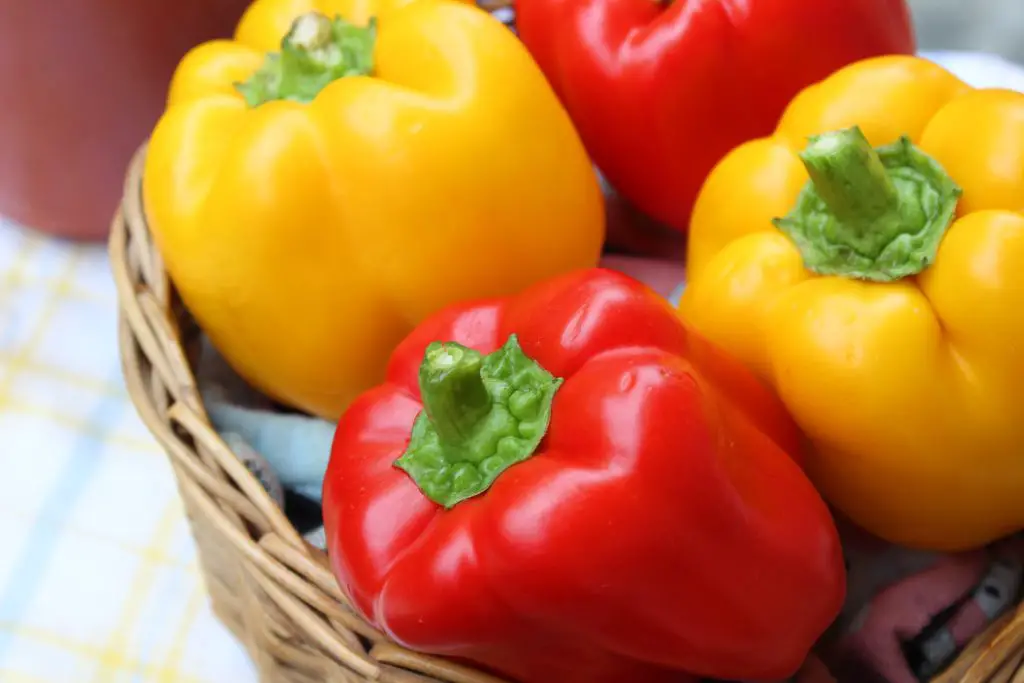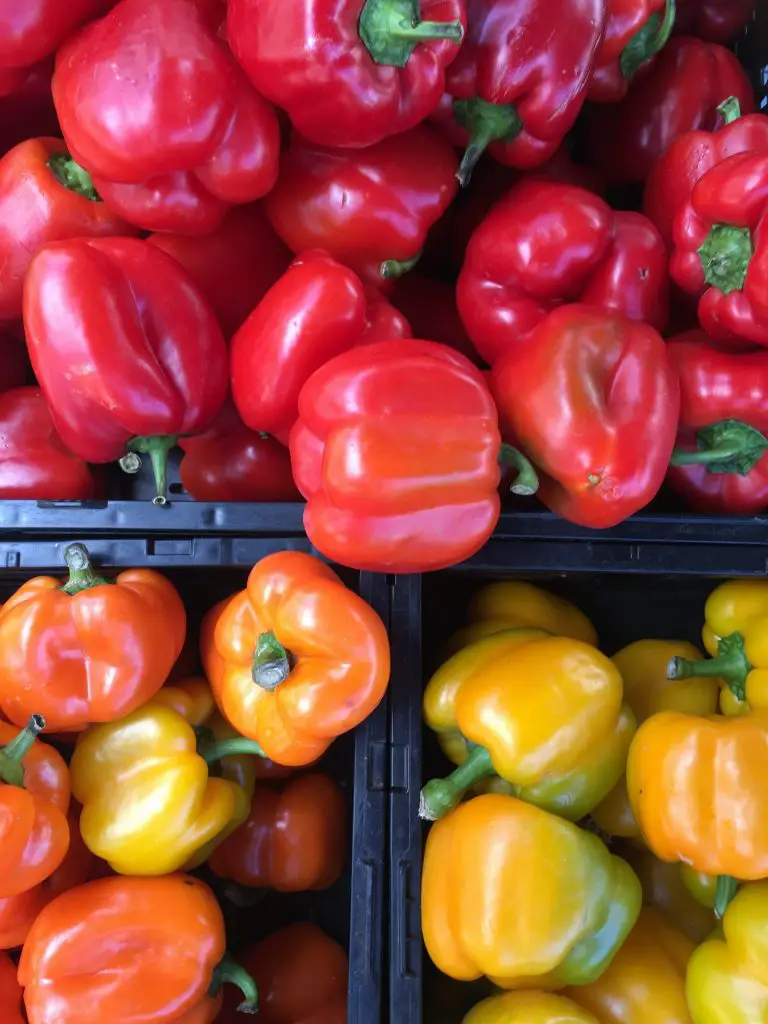Are Capsicum And Bell Peppers The Same Thing? Bell Peppers are among the most popular and versatile fruit available as they can be used in a variety of dishes. Additionally, they are frequently eaten raw in salads or as a healthy snack in school lunch boxes. However, Bell Peppers are sometimes referred to as Capsicums, so is that a specific name of a type of bell pepper or are they the same thing?
The term Capsicum is used to generally describe bell pepper in countries such as Australia and New Zealand. However, Capsicum is the name of the genus that the plant comes from which includes sweet, bell, and hot peppers. In countries such as Australia, the term capsicum is generally used to refer to any peppers that don’t contain heat, such as sweet or bell peppers whereas spicy peppers tend to be referred to as chili peppers.
The other confusing area around the naming of the fruit is the difference between a bell pepper and sweet pepper. Bell and Sweet peppers are the same species and are very similar to each other except that the sweet pepper is removed from the plant later which produces a sweeter taste as the sugar within the fruit has more time to develop.
This development of sugar is also often accompanied by a change in color, most peppers start off green and then eventually color to yellow or red.

About Capsicums
The Capsicum genus is included in the Solanaceae family, which is sometimes also referred to as the nightshade family. The family originated in the Americas and includes several other popular edible plants such as potatoes, eggplants, and tomatoes as well as toxic plants such as the deadly nightshade.
The plant is a frost-tender perennial that originated in a warm climate however, the majority of gardeners treat the plants as annuals and replant the seed every year. As mentioned above the plant is referred to by many different names which include peppers, capsicums, and chillies.
The name pepper comes from the fact that the plant has a similar taste to the black pepper plant (Piper nigrum) however the plants are completely unrelated. Whereas the term chilli comes from the Aztec word for the fruit.
Within this genus, there are some varieties that contain the chemical capsaicin which is responsible for the burning sensation felt when it comes into contact with any type of tissue. However, this burning sensation only affects mammals, birds are unaffected by the chemical.
The quantity of capsaicin in the fruits varies depending upon the particular varieties. The most common unit used to quantify the heat of the fruits is the Scoville heat unit (SHU). This unit was originally based on the number of many parts of sugar water it took to neutralize the heat. The test was later replaced with an analytical test method hat detected the quantity of capsaicin present in the fruit.
The range of SHU varies enormously with values ranging from 0 to up to over 2 million units. The sweet and bell peppers have a rating that is 0 and common Jalapenos have a heat rating of between 2,500 to 10,000 to give some reference to the table below. To read more about the hot varieties click here.
| Heat | Scoville Heat Unit |
| Extremely Hot | Above 80,000 |
| Very Hot | 25,000 to 70,000 |
| Moderately Hot | 3,000 to 25,000 |
| Mildly Hot | 700 to 3,000 |
| Non Pungent | 0 to 700 |
In terms of cultivation, members of the capsicum are known to have been first cultivated in South American around 7500 BC. The cultivation of the plants later spread to Central America somewhere between 5200 and 3400 BC. However, it wasn’t until the discovery of the Americas in 1492 that this group of plants was introduced to Europe.
It has been suggested that Christopher Columbus was personally responsible for introducing the plant to Europe and also naming a variety ‘red pepper’ due to its similar taste to the black pepper. However, there is no direct evidence, that has been found to date, that has been able to confirm this.
When the peppers arrived in Europe they quickly gained popularity in a range of different cuisines and were later spread to Asia and Africa by Portugese sailors and merchants. This is in contrast to tomatoes, that were treated with suspicion, due to their similar appearance to deadly nightshade.
One of the other reasons why the pepper is believed to have gain popularity so quickly is because it could replace black pepper, which at the time was extremely expensive spice.

How To Grow Capsicums
Capsicums (Peppers) are relatively easy plants to grow and generally can be successfully produced in the same locations that tomatoes are grown. However, Peppers require more heat than tomatoes to get a reasonable crop, so if you live in a relatively cold climate it is recommended that additional heat and protection be added.
Seeds need to be started in early to mid-spring and the germination temperatures ideally need to be 59°F (15°C) or greater which means for most locations it will be necessary to start the plants off indoors. Seeds trays should be placed in a location within the house that has plenty of light and warmth.
However, as it is common for the temperature to fluctuate it is recommended that a heated propagation tray be used. Heated propagation trays provide the ideal growing conditions for germinating seedlings and they are not overly expensive to purchase. The one we recommend is the iPower Heating Seed Starter Germination Kit, shown in the picture below largely because it has a vented humidity dome. Click on the link to see the current price on Amazon.

Planting Seeds
When planting seeds it is best to sow them at a depth of 0.5 inches (1 cm) into seeds raising mixture. It is recommended that you sow 2 seeds per cell to ensure that you get at least one plant per cell germinating. Additionally, it is a good idea to sow approximately 50% more seeds than you think you need, as this will ensure that you have enough plants to meet your requirements, as it is common to have seeds not germinate or have the seedlings destroyed.
Once planted seedlings will typically take 7 to 14 days to emerge, at which point they need to be kept moist constantly. The seedlings will need to spend at least 6 weeks in the trays before they can be planted out. When planting the seedlings in the garden the temperatures ideally need to be 68°F (20°C) or greater.
The plants should be spaced approximately 1 ft apart in rich, moist but free-draining soil. As the seedlings are susceptible to attack from slugs and snails it is advisable to sprinkle snail pellets around the plants. Additionally, the application of a physical barrier, in the form of a cloche, will also help to protect the young seedlings. In addition to protecting the plants the cloche will help to increase the temperature.
Caring For Plants
At the plants become established it may necessary in some cases to provide a little support in the form of a single stake. Peppers generally do not require the same degree of support as tomatoes because the plants are not as tall and the fruit is not as heavy.
In addition to supporting the plants it is important to ensure that the soil remains moist by regularly watering the plant and also applying a thick layer of mulch to minimize evaporation. In locations where the weather is cool at night, it is advisable to protect the plant with a row cover. This is particularly important at the end of the season when an early frost is a possibility.
Conversely, where there is extreme heat, greater than 100°F (38°C) it is advisable to apply a shade cloth particularly when the plant is flowering but has yet to set fruit. The reason for this is at extreme temperatures the flowers can drop off.
The fruit can be harvested at any stage once they reach a reasonable size however, it is best to wait until a color change in the fruit is observed as this will ensure the that fruit is as sweet as possible.
Related Articles
What Are The Different Types Of Hot Peppers?
Why Are My Pepper Plants Not Growing Peppers?
How Many Jalapenos Do The Best Pepper Varieties Produce?
Pepper vs Black Peppercorn: What Is The Difference?
Capsicum vs Bell Pepper: Are They The Same Thing?
Are Dried Peppers Hotter Than Fresh Ones?
